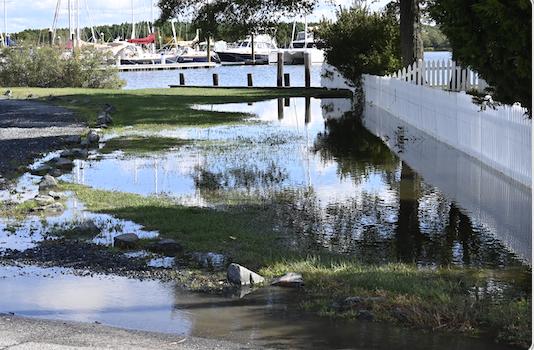The news reports were ominous—high tides on parts of the Eastern Shore would be four feet over normal. Not good. And there isn’t much to do about it other than moving whatever looks as though it could float away or be destroyed by water to a safe location if you are lucky enough to have one.
The two high tides of the “weather event” occurred while I was out of town. I monitored the news closely and activated a few security cameras to see if my yard was now a lake. I was relieved not to find someone’s boat in my backyard. All seemed well, but there is no substitute for looking at things directly.
On Saturday morning, I returned home from DC. From bridges, I could see that water levels were high, but the roads on my route, 50, 322, and Oxford Road, were clear. No water and, more importantly, no signs that there had been flooding.
After getting home, I loaded my goldendoodle into my car to see what was going on in the town of Oxford. The worst of the flooding was now more than 12 hours ago. How bad could it be?
The answer to that is that there were signs of flooding everywhere. A family was canoeing near the tennis courts. Several roads were closed with cones. From a distance, you could see that parts of some streets remained under water. You also could see evidence of “high water marks” on several buildings. The water, I learned, had been at least two or three feet higher than what I was seeing.
The flooding was nothing like 2012, when Hurricane Sandy left much of Oxford underwater, but was a reminder that Oxford, like most of the Eastern Shore, is vulnerable to flooding. As I looked at the minor flooding this year, I thought, “What will we be seeing ten years from now?”
I took my dog to the Strand. The beach was underwater. Several people were walking the strand, not only enjoying the pleasant weather, but also curious about what had happened. From talking to a couple of them, I sensed they were relieved. “We dodged a bullet,” one of them said.
Interested in documenting evidence of the flooding, I shot a few photograph. In reviewing them for this story, I found them sorely lacking in the sensationalism one expects in any article that references climate change. By themselves, the photographs are not especially alarming. But taken together with this year’s bizarre weather nationally–“bomb cyclones,” massive fires in Oregon and California, and an unusually high number of hurricanes—suggest that more trouble is on the way. Viewed from this perspective, our recent flooding is another prelude to “a big one,” a weather event devastating our region.
That thought is depressing; hopefully I’m wrong. But, if you believe the weather scientists, our vulnerability to flooding and hurricanes is increasing. We should be worried, but many of us are not, at least not enough to take action. Some continue to question the scientists. Others, even some that accept Climate Change as serious risk, doubt anything can be done about it.
What will it take for voters to agree that climate change is an existential threat? That is the question that comes to mind as I read in The Spy and elsewhere about new real estate developments on the Eastern Shore that, if some scientists are to be believed, will be subject to regular flooding in as little as 20 or 30 years.
It’s not clear what the Eastern Shore and dozens of other places in the U.S. that face the threat of routine flooding and “super storms” can do to prepare. Building new sand dunes in Oxford to stem erosion of the shore is not a solution. It’s a Band-Aid—a welcome Band-Aid—but only a fool would suggest it is anything other than a Band-Aid.
The tougher question for Eastern Shore counties, the State of Maryland, and, yes, the Federal government, is whether its time to stem development in areas that face the greatest vulnerability from flooding and worsening extreme weather. Until the trend towards worsening, life-threatening weather has been stemmed, development in vulnerable areas is foolhardy. When that new development gets destroyed or damaged in the next storm, who is going to pay the bills to compensate for the damage?
Is it appropriate to view the recent flooding as a wake-up call? I would argue yes, although for anyone regularly reading about this year’s weather, it was the 100th wake-up call. Will we respond to it? And if we do, how do we find the national resolve to respond in a meaningful way?
If you have not watched the Spy’s short video documenting some of the flooding in Oxford, you can watch it here.
J.E. Dean is a retired attorney and public affairs consultant writing on politics, government, birds, and occasionally, golden doodles.



Steve Park says
Come on J.E. don’t let science get in the way of your advocacy……..The public debate long ago abandoned science for advocacy—as when “global warming” became “climate change” after some cold winters. temperature take points are mostly at airports, has BWI gotten bigger or smaller over the last 50 years. More planes, more concrete. Move the temp take spots into the corn fields outside of Oxford and then lets redo the science.